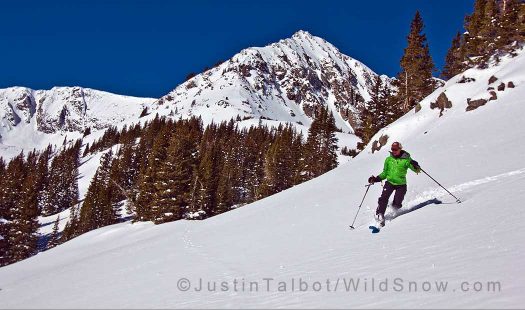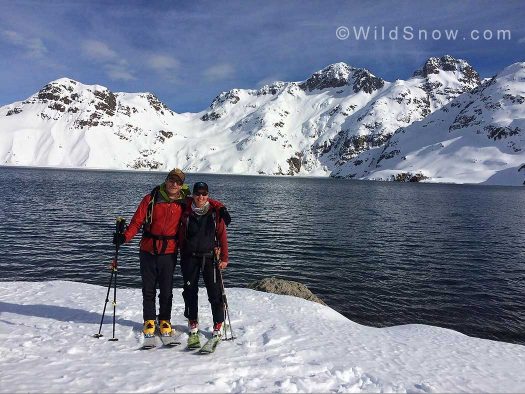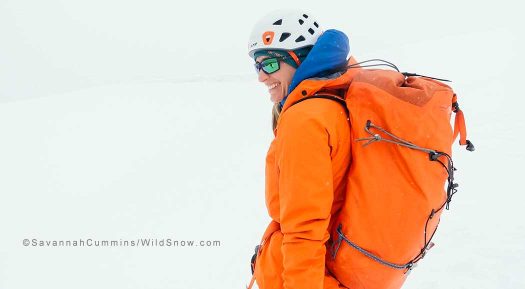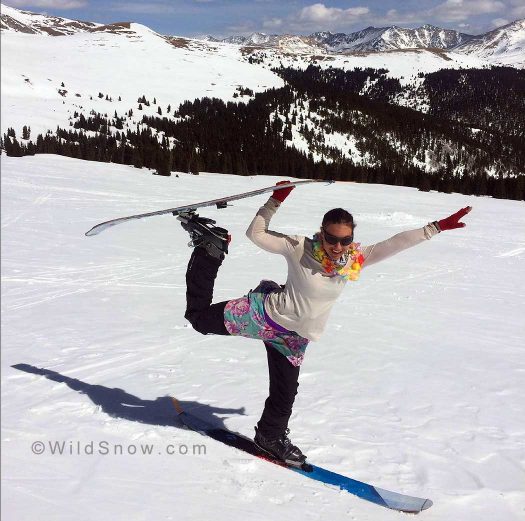Margi Dashevsky
I grew up in Alaska and I relish skiing when it’s 40 below zero. Even though my skis don’t glide and the snow feels like sandpaper, it is life affirming when my breath frosts my eyelashes.
I love snow. I have logged countless hours skiing out-of-bounds, both professionally and personally, yet I don’t always identify as a “backcountry skier.”
As with most extreme sports, backcountry skiing culture tends to highlight highly motivated thrill seekers who go fast, hard, and bold. I prefer to go at a conversational pace and seek carefree fun, not adrenaline. Clearly, we as a community can broaden what constitutes “cool backcountry skiing” to better include those of us who are less objective-driven.
I married an avid ski-mountaineer (WildSnow guest blogger, Alex Lee) and in navigating the differences in our mutual infatuation with snow I’ve discovered nuance and insight in our dissonance. We ski almost every day in winter, and people presume we ski together, but chances are while he heads to a big mountain objective I’m carving tele turns in 20 degree trees.
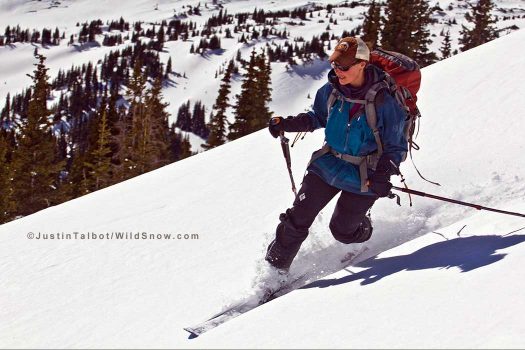
Carving turns in my happy place while teaching 11 th graders to be comfortable living in the snow (photo by:
Justin Talbot).
Alex wrote about Katie Bono’s speed ascent on Denali, that sparked a chain of comments about sexism in outdoor recreation. I was excited that people were talking about gender on WildSnow and I immediately wanted to chime in, but was unsure how to do so. My hesitation, both in writing a comment and in my cautious choices of ski terrain, may shed light on why female skiers like Katie are still an exception, not the norm.
I thought about how impressive Katie is. I thought about the power of her accomplishment, regardless of gender (anyone climbing Denali that fast is inspiring). I also thought about the power of her accomplishment because she is a woman (due to biological and social barriers women must overcome). Irrespective of how important gender is, or should be, in framing Katie’s achievement, gender is part of both her and my stories.
Katie’s ease with identifying her physical limits, and not letting fear hold her back, is a secret to her success. Female athletes like Katie, who are crazy smart and crazy skilled, have something to teach all of us: Katie is conventionally rad — exceptionally hard-working and driven with a remarkable tolerance for suffer-fests — but also cautious, risk averse, and profoundly humble.
It’s those latter qualities I aspire to, and to add a few things: joyful camaraderie, conservative decision-making, and artful powder-eights.
Few things scare me more than avalanches (except maybe grizzly bears). I often go out of my way to ski around avalanche terrain. Because of this I don’t talk about skiing gnarly lines and there aren’t pictures of me dropping steep faces. That’s just not my jam. When media about backcountry skiing showcase extreme lines a) I don’t relate to them, b) it overshadows the majority of skiing we all do, c) it downplays the value of the type of skiing I most enjoy. When backcountry ski culture favors aggressive shredders it can easily exclude people like me, who are disproportionately women, due to interrelated biological and social realities.
For example, I don’t build muscle mass as quickly as my male counterparts and my strides are shorter because I am only 5’2″. These physiological factors compound and I get frustrated at myself if I can’t keep pace. Like many people, I can get impatient with bro culture and am uncomfortable in male-dominated spaces. I appreciate the shift a critical mass of ladies can bring to a ski group’s dynamic because I feel like I can be more open and I more confidently chime in.
My last tour this winter was a typical dog-walk/ski-jaunt in the Mosquito Range outside of Leadville. It was a sunny mid-May day and we drove a few blocks uphill to what I like to call Leadville’s Refrigerator, because it holds snow weeks after town melts out. On the skin I caught up with a close friend, and then peeled off with the dogs to descend my carefree backyard run, while he and Alex continued on. While they were huffing and puffing on crusty junk snow trying for a summit, I was blissfully savoring sweet spring snow . . . how cool is that!
I’m left wondering. Can we as backcountry skiers collaboratively create a more inclusive community that is comfortable and welcoming, not just for women, but for all people? For example, why do so few people of color ski? Can we expand our metrics of success to include diverse accomplishments in the backcountry?
We all spend a lot of time talking about conservative decision-making and most everyone skis the same mellow terrain mid-winter, but the imagery, media, and a large cultural component of the backcountry world equates skiing burly lines (and taking risks) with being badass, and ultimately with being a ‘cool’ backcountry skier. Katie, Alex, and I all have reasons to be proud backcountry skiers; I will continue to celebrate Katie’s super-human-ness and Alex’s thrills as I rejoice with bouncy turns, in glorious and often low angled pow — even when the temperature warms well above my coveted 40 below.
WildSnow Guest blogger Margi Dashevsky has been sliding on snow since she could walk. Margi loves exploring the outdoors and sharing the process of discovery as a science teacher and guide. She lives in Alaska.
Beyond our regular guest bloggers who have their own profiles, some of our one-timers end up being categorized under this generic profile. Once they do a few posts, we build a category. In any case, we sure appreciate ALL the WildSnow guest bloggers!

